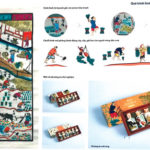The Vietnamese Colors of Hang Trong Painting Project is carried out by a group of youth in Hanoi with the desire to provide in-depth analysis and specific methods as well as the potential application of colors, patterns of this kind of folk paintings in modern life.
The answer from the tradition
Hang Trong Painting is one of the typical folk lines of Vietnam, and is also considered as the representative painting line for Thang Long land crystallizing a lot of aesthetic, spiritual and religious values of the ancient Kinh. However, products bearing the soul of Thang Long – Hanoi is gradually back to the past. This painting line is only kept in the museum and in the collection of a few rare collectors. How to preserve, store and develop that identity? Where is the design style imbued with Vietnamese and make the words “Vietnam” cannot be mistaken in global design? These questions led the graphic designer Trinh Thu Trang to concern. While by only one click, we can access thousands of books, rich in design styles from Japan, China, Korea, England or France, the source of the style of Vietnamese design can be considered very little and faint.
When approaching and studying about Hang Trong paintings, the designer Trinh Thu Trang determined to preserve this valuable value. This is also the reason that the SRiver group has founded and implemented the The Vietnamese Colors project, with the first product is the book named The Vietnamese Colors of Hang Trong painting for design, fine art and the people who love the folk culture of Vietnam. Received expert consultation and positive reviews from art researchers, the book as a repository of folk-color data, bringing the breath of traditional art into modern design.
The designer Trinh Thu Trang shared, through the mentioned aspects, the project aims to create a new approach to maintaining and preserving traditional values. Do not try to put the tradition into reality, do not try to pull things of history, what the book is aimed at distilling what from the potential folk material into modern life, into the current work of graphic designers, fashion designers, interior designers or many other artists. “It’s a way for old values to come back, so that they are not just permanently resting in the museum, but anywhere in life they can be easily seen. Because culture is like a stream and each one is like a drop of water, many drops of water are tangled together and going in one direction will form the flow”, said the designer Trinh Thu Trang.

Vietnamese rice cake with the application of Hang Trong painting on the packaging
Photo: Hong Nhung
Data of folk arts
The core values of arts from a thousand years are still reflective of culture and social life. This is also what the author of the book The Vietnamese Colors of Hang Trong Paintings wants to focus, came back to the traditional culture to find the value of identity. At first glance, it is supposed to have the similarity between the countries in Asia, but the reality shows that the expression or spirit in the Hang Trong painting still has a distinct “soul” and imbued with identity of the Vietnamese. In Hang Trong paintings, the ancient artists used all the strong contrasting colors, blue, yellow, red together, creating aesthetics, attractive colors.
The book is considered as a valuable document to support study and research, while helping designers apply the color and design of Hang Trong paintings on the work. In addition, the materials in the book also help to research and promote the value of the paintings lines such as Dong Ho or many other folk arts in the design.
As can be seen, the source material from folk can become the basis for developing new design ideas. However, the challenge is to access this unique source of material, as folk art culture is rapidly forgotten. Therefore, it is necessary to have more individuals and organizations involved in research and ideas to filter and preserve the essence of traditional culture for use in modern life.
According Daibieunhandan

